The 800V System and EQS: A Comparison from P3 Automotive Lab
There is an additional process to the existing 400V battery system which has produced the strongest sustained capability yet. Mercedes-Benz’s EQS has taken some considerations towards fast charging. To compare, we refer to the evaluation from P3 lab, a document named “Comparison Of The Fast Charging Capability Of Different Electric Vehicles From An User Perspective.”
P3 Automotive Test Results
This company’s models mainly include Taycan, EQS, E-tron, Tesla’s Model 3, X, and S, BMW’s iX3, Mercedes-Benz’s EQA and Volkswagen’s ID3&ID4, Polestar 2 and Ford’s Mach E. In the 10% – 80% charging phase, P3 provides their test results for the typical models, which are:
- Porsche Taycan with an average charging power of 184 kW and a peak power of 270 kW
- Mercedes-Benz EQS with an average charging power of 164 kW and a peak power of 207 kW
- Audi E-tron with an average charging power of 146 kW and a peak power of 150 kW
- Tesla Model 3 with an average charging power of 146 kW and a peak power of 250 kW
Note: The relationship between peak and average values varies among brands and is affected by environmental temperature.
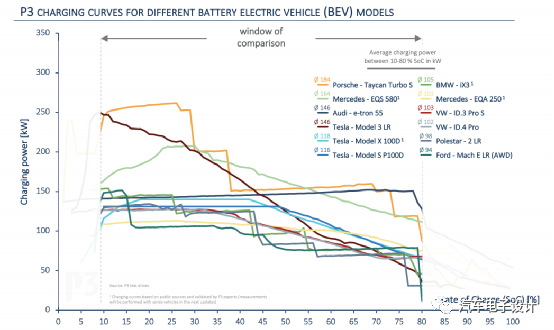
P3 additionally conducted an energy consumption test.
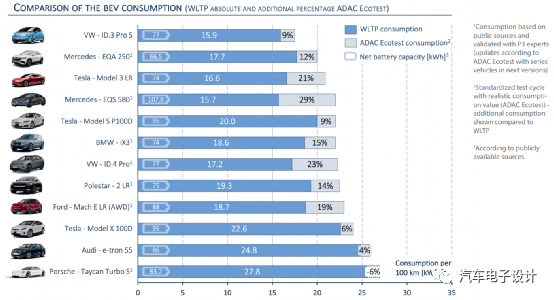
Based on the energy consumed during 10-minute and 20-minute charging periods, and the energy consumption during driving, charging distance data is derived. P3 data indicates that EQS tops the charts: the 108 kWh battery can accept a relatively sustained and constant charging power, achieving 144 km and 266 km driving distance during a 10-minute and 20-minute charging period, respectively.
Note: The official EQS promotion claims 300 km driving distance with a 15-minute charge, and this charging-time-to-distance promotion is currently used in both Europe and the US.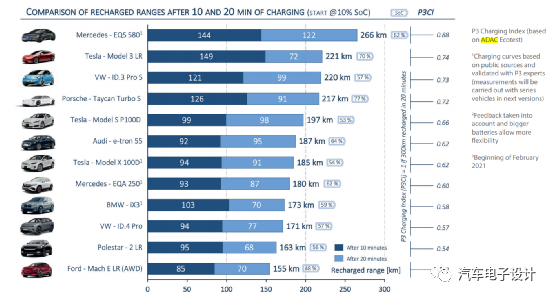
Charging Curve of EQS
I found several other data sources and basically confirmed that Mercedes-Benz designed the EQS based on the standard specification of 400 V and 500 A. This requires appropriate handling of the battery cells at suitable temperatures. Under ideal conditions, the EQS can ramp up to 200 kW from around 8% State of Charge (SOC). The curve has two sloping segments, with a drop in power from 200 kW at 31% SOC to 120 kW at 80% SOC, and a further drop from 120 kW to 60 kW at 90% SOC.
Note: The charging power curves of EQA and EQC are quite similar.
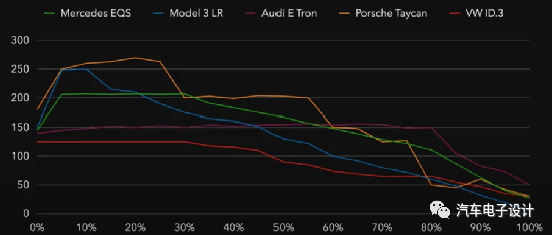
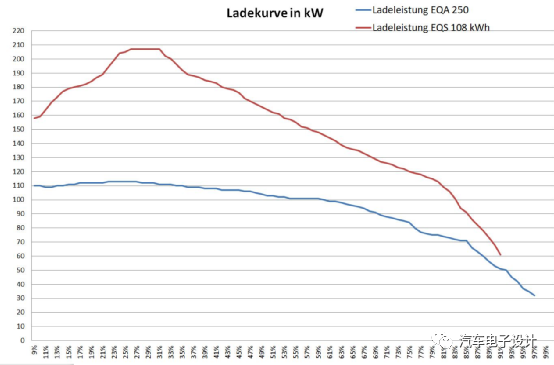
The current battery pack configuration is unknown and it is uncertain if it is similar to the EQC, with two branches running in parallel in the high-voltage system, which can divide the 500 A into two 250 A branches.
Note: In Volkswagen’s MEB, the battery cells have a 2P configuration. Therefore, it is possible that Daimler’s typical practice is to use a 1P configuration and expand it in parallel to the entire branch, making it easier to switch to 800 V.
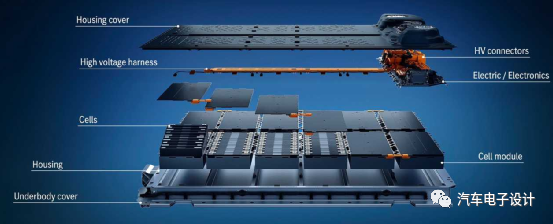
Summary:
Based on the 400 V and 500 A specification, the design of the entire electrical system is quite challenging. I am actually more concerned about the electrical design of this battery pack, especially since we need to reach 200 kW under the condition of 400 V busbar. The design of this pack is basically at its limit.
This article is a translation by ChatGPT of a Chinese report from 42HOW. If you have any questions about it, please email bd@42how.com.